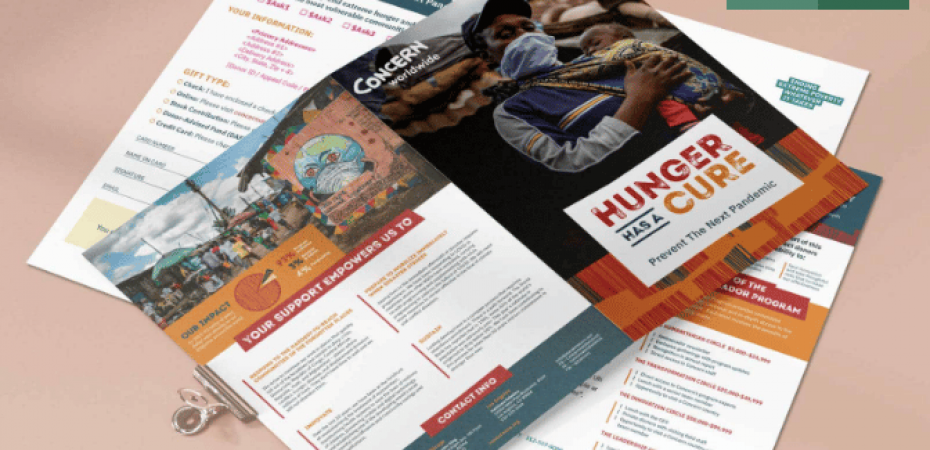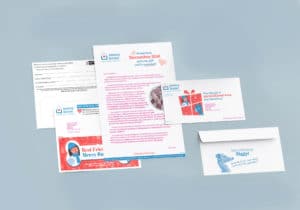What is direct mail?
Direct mail is a physical mail piece usually sent through the US post office. It can range from a letter in an envelope, to postcards, to catalogs to brochures and even small packages. It is a great way to market to a diverse audience. You can send a simple appeal for funds, a small gift or just a thank you or welcome message. It is a cost-effective way to reach a large number of loyal donors and find new donors.
How is direct mail useful for nonprofits?
Non-profits use mail in a variety of ways. They use it for communications, updates, thanking donors, and of course fundraising. Many groups leverage this highly effective channel to communicate to a wide range of their constituents, from donors to volunteers to any supporters of their work.
Using direct mail to fundraise is still one of the most effective channels to engage with donors. You can share the impact of their contribution and also at times, offer small thank you or mission related gifts.
One of the goals for any fundraising program is to find planned giving prospects, mid-level and large donors, especially prospects with donor-advised funds and other charitable giving accounts. Oftentimes, we find that many of these donors first started giving to an organization through the mail responding to an acquisition package. This is one reason many non-profits invest in direct mail as a feeder program. They want to maintain a large pool of donors so they can mine these valuable prospects from their file and ensure the long-term success of their overall fundraising efforts.
What type of people do you generally reach with direct mail?
In addition to people who are already connected to an organization in some way, you can also utilize direct mail to target donor prospects. There are many different lists that are on the market, from non-profits to co-ops and to for-profit organizations. Direct mail donors and prospects do tend to skew older, they have disposable income and still like the mail as a giving vehicle. This is why they are such a valuable audience for planned giving and mid and large gifts.
Is direct mail helpful in retaining donors? If so, how?
The short answer is YES. The best way to retain donors is to provide a consistent stream of communications. This is important because people will give at different times and when it’s most convenient for them or if something is hitting the news cycle. Mail offers the opportunity to reach your donors with a variety of pieces, and messaging can start right on the envelope or even postcard. So even as a donor is sorting through the mail, they see your messaging. Also, donors acquired by mail are more likely to renew through the mail. This is especially true for older donors who are the mainstay of many mail donor programs. You work to retain a donor with mail through their life cycle, with the ultimate goal of having them leave you a legacy gift.
Is direct mail still relevant? Shouldn’t digital marketing be preferred?
An integrated mail and digital approach is best. As donor behavior shifts, whether it be in mail or online, you have to meet them where they are. By adding multi-channel touchpoints, you allow donors to give through the channel they prefer. We see that when clients integrate mail with email, there can be a 29% increase in donor retention. And if you move to a multichannel approach, retention can increase by 56%. It’s better to look at a program as a whole and see how each channel can work together to build and enhance your fundraising program.
What are your best tips for a successful direct mail campaign?
Test! Direct mail is often counterintuitive and the best way to know if a technique will work is to test. As long as your file is not tiny, there are tried-and-true techniques that you can utilize to find out what works for and resonates with your audience.
Another way to assess your direct mail campaign program success is through data –it’s really all about the numbers. To track your campaign performance, you will need to have a system of codes on all response forms so you know from which campaign responses are coming. There are also key performance indicators and industry benchmarks to help you measure if a campaign is working or not. Some common ones include ROI, Long-Term Value, Retention Rates, and Upgrade/Downgrade on gifts.
With inflation and the market downturn that we are seeing, how does this affect direct mail?
This is actually a great time to step back and evaluate your program to find cost efficiencies and really home in on your best donors. Despite the uncertainty of what is happening, we recommend that clients continue to fundraise and not be afraid to ask for donations. Donors will give where there is need even when the economy is shaky. That’s why we’ve been looking for a lot of resourceful ways to help clients save on expenses to combat rising paper and postage costs. Things we do include combo printing more mailings during the year to take advantage of economies of scale, cutting back on some less productive donor segments, using first-class postage versus third-class rate and using low-cost enhancements that we know will help lift response and possibly average gift. These are only a few examples and with some creative thinking, there are a multitude of techniques to combat rising costs and mitigate risks.
What are the biggest trends to follow in direct mail in 2022?
We’ve been seeing an increase in mail and digital integration like QR codes to push donors to give online, retargeting so donors and prospects are reminded of the organization’s messaging and branding both offline and online, and push for donor-advised fund gifts. There are now more cooperative lists coming into the market for new donor acquisition, retention, reactivation and upgrades – using machine learning to develop sophisticated data modeling to better target donors and prospects.
Faircom New York has 30 years of experience in direct mail marketing for nonprofits organizations. Whether your direct mail program is already well-established or you are just starting out, we have the experience to guide you through the process and develop a direct mail strategy that will best meet your needs and your budget. Contact us now!




